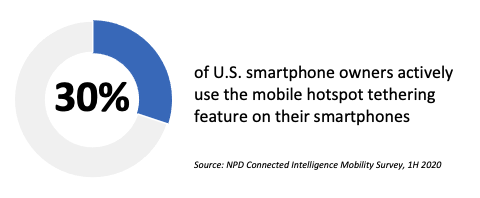
Samsung debuts new A-series smartphones
During a virtual “Unpacked” event, Samsung announced updates to its popular Galaxy A series phones. The OEM announced three new models; the Galaxy A72 5G, A52, and A52 5G. The Galaxy A72 is Samsung’s upgrade to the Galaxy A71 5G model, which has been offered by all postpaid carriers for as low as $150 with new activation (at AT&T). The new A72 5G boasts an impressive spec sheet including a 6.7-inch FHD+ Super AMOLED display with 90Hz refresh rate, quad rear cameras including a 64 MP lens and a telephoto lens with 3x optical zoom and optical image stabilization, and a 5000 mAh battery. The A72 also comes loaded with Snapchat’s AI camera filters as well as its Knox security software, which typically targets enterprise users but also addresses the privacy concerns of consumer users.
The A52 and its 5G-powered cousin A52 5G, on the other hand, is the upgrade to the Samsung Galaxy A51, which has been one of the most popular switcher promotion phones during the fourth quarter. The new A52 models are slightly smaller in size (6.5-inch display) and lighter in specs (smaller RAM, battery, and exclusion of the 3x optical zoom telephoto lens) compared to the A72 5G, but the phones also support the Snapchat filters featured on the A72 5G. Incidentally, the A52 5G version, actually exceeds both A52 and the A72 5G in display technology as the phone’s screen supports up to 120 Hz refresh rate, a feature typically found on flagship phones. Samsung did not provide any update on the US arrival dates and versions of these new models, but the OEM’s FCC documentations reveal that at least the A52 5G is getting ready for a debut at AT&T and T-Mobile in the coming months. The price of the new A52 is announced to be 349 Euros (around $419), while the 5G version will cost an extra 70 Euros. The Galaxy A72, on the other hand, is priced at 449 Euros ($539).
The NPD Take:
- Samsung’s pricing on the new Galaxy A series models is aggressive considering all the extra features added to the phone. Imaging, display, and battery have long been the major motivators impacting consumers’ new phone purchase decisions, and Samsung’s new A-series phones fully address these consumer preferences.
- The small price and spec list differences between the new Galaxy A52 5G and the A72 5G is a possible indicator that Samsung may not initially debut the A72 5G in the US market. The phone’s enhanced imaging features (such as the support for OIS and 3x optical zoom capabilities) coupled with its attractive design and pricing have the potential to cannibalize the sales of its flagship S21 5G smartphone. The A52 5G’s 120 Hz refresh rate capable screen and other features such as the Snapchat lenses and Knox support should give Samsung and its carrier partners sufficient marketing bullet in a landscape where the closest Android rival LG is nowhere to be seen.
T-Mobile to penetrate national distributors
T-Mobile has had an impressive run in the US mobile market since the debut of its first Uncarrier move in March 2013 when it killed off service contracts. T-Mobile’s unstoppable subscriber growth since then was attained through a narrow-focused direct channel effort that ignored alternative national distributor channels such as Walmart, Target, and Best Buy. The carrier, during its recent Virtual Analyst Day, announced a major shift in course as it is getting ready to join forces with Walmart and Best Buy for the sales of its phones and services. T-Mobile’s services will soon be available in 2,200 Walmart locations, nearly a thousand of which are located in rural markets where T-Mobile has limited or no reach via its distribution network except its digital channels. The carrier also announced that its postpaid and prepaid services (the Metro brand) will also be available through nearly a thousand Best Buy stores. Finally, T-Mobile will be launching close to 500 new “multi-carrier” retail stores that will offer both Magenta postpaid and Metro prepaid services by the end of 2021.
The NPD Take:
- As we reported during our 2020 market update presentations, the pandemic has taken its toll on the US mobile channels, which have long been dominated by carriers. In the second quarter of 2020, we had seen the carrier channels (retail and digital) shrinking in activation share due to store closures, and open doors such as Walmart enjoying a boost in share. As we are a year into the pandemic, the direct carrier channels have yet to recover the lost ground and T-Mobile’s absence in the indirect carrier channels has simply meant opportunity lost for the carrier.
- T-Mobile’s entry into Walmart is alarming for rival Verizon, who is getting ready to take over Tracfone. The prepaid MVNO’s main brand, StraightTalk, is sold exclusively at Walmart stores and it enjoys close to half of all devices sold at this channel. The debut of the T-Mobile postpaid, but more importantly, the Metro prepaid brand at Walmart equates to a tougher competitive environment for Tracfone and Verizon.
- The Sprint acquisition has given T-Mobile a great opportunity to combine its low-band spectrum and Sprint’s large mid-band spectrum to blanket the entire nation, including the hardly-reached rural areas, with 5G connectivity. The Walmart agreement should help T-Mobile tremendously in distributing its mobile and fixed wireless Internet services to a customer segment that has little awareness of the T-Mobile brand.
- Best Buy is the nation’s largest seller of unlocked smartphones, and while T-Mobile a small portion of the unlocked BYOD activations, it trailed behind Best Buy’s existing carrier partners AT&T and Verizon, which cross-promote Best Buy’s unlocked smartphones with additional incentives. T-Mobile’s entrance into Best Buy should help boost T-Mobile and Metro’s share of the unlocked device activations in the coming quarters.


